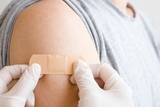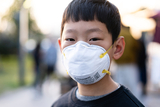Please refer to this helpful information about COVID-19 symptoms and what to do if your child is exposed to COVID-19.
What is coronavirus disease 2019 (COVID-19)?
Coronavirus disease 2019 (COVID-19) is a respiratory illness. It's caused by a coronavirus called SARS-CoV-2. There are many types of coronaviruses. Coronaviruses are a very common cause of upper respiratory tract infections, or the common cold. They may sometimes cause lung infection (pneumonia). Symptoms can range from mild to severe respiratory illness. These viruses are also found in some animals.
Scientists continue to actively research COVID-19 and variant strands of the virus that causes it. Visit the CDC website for the latest information.
What causes coronavirus disease 2019 (COVID-19)?
COVID-19 is caused by the virus SARS-CoV-2. The virus is primarily spread through large droplets of fluid that a person coughs or sneezes into the air. It may also be spread if you touch a surface with virus on it, such as a handle or object, and then touch your eyes, nose, or mouth.
Who is at risk for coronavirus disease 2019 (COVID-19)?
You are at risk for infection if you had close contact (more than 15 minutes at a distance of less than 6 feet) with a person who was diagnosed with or who may have COVID-19.
Are children less prone to infection with COVID-19?
Scientists continue to study how children, particularly those who are unvaccinated, are impacted by this virus. In the beginning of the COVID-19 pandemic, children were less likely to experience severe infection. We continue to see severe illness leading to hospitalization in the pediatric population among children who are unvaccinated, children who are immune compromised, and those with complex medical conditions. We recommend taking all necessary precautions to keep your children safe, including mask use when the virus is highly prevalent in your community, excellent hand hygiene and vaccination.
What do we know about the role of children in disease transmission?
Children who carry SARS-CoV-2, the virus that causes COVID-19, may be asymptomatic or mildly asymptomatic. However, children of all ages can contribute to disease transmission and it is critical that children who test positive for the virus follow isolation protocols.
What are the symptoms of coronavirus disease 2019 (COVID-19)?
Some people have no symptoms or mild symptoms. Symptoms can also vary from person to person. Symptoms may appear 2 to 14 days after contact with the virus, though most will develop symptoms within the first 5 days after exposure.
Symptoms concerning for COVID-19 in children include:
- Cough
- Shortness of breath
- Difficulty breathing
- Loss of taste or smell
Additional non-specific symptoms may be due to COVID-19, but may also be due to another infection. These symptoms include:
- Fever
- Sore throat
- Runny nose
- Headache or body aches
- Chills
- Fatigue
- Gastrointestinal symptoms such as vomiting or diarrhea
It is important to review your child's symptoms with their doctor to determine if they should be tested for COVID-19. Vaccinated children have milder symptoms than unvaccinated children.
How is coronavirus disease 2019 (COVID-19) diagnosed?
Your healthcare provider will look at the risk of COVID-19 in your community and will ask about your symptoms. They will also ask about your recent interactions with others and contact with sick people. If your healthcare provider thinks you may have the virus, they will recommend testing.
COVID-19 is diagnosed through a nasal swab. A cotton-tipped swab is wiped inside your nose. This test looks for evidence of the virus to tell you if you have a current COVID-19 infection. Many at home tests are available at your local pharmacy.
If your healthcare provider thinks or confirms that you have COVID-19, they will recommend additional testing based on your child’s symptoms.
Follow all instructions from your healthcare provider.
How is COVID-19 different from the flu?
Both COVID-19 and influenza are respiratory viruses. Because of this, they can cause similar symptoms of cough, difficulty breathing, shortness of breath, fever and body aches. Call your child’s pediatrician to discuss any symptoms. They may recommend testing to determine which virus your child has and consider treatment based on your child’s age and underlying medical conditions.
How is coronavirus disease 2019 (COVID-19) treated?
Select medications are recommended for children admitted to the hospital with severe cases of COVID-19. Oral medications are available for older children at high risk of progression to severe disease.
The most proven treatments right now are those to help your body while it fights the virus. This is known as supportive care. Supportive care may include:
- Getting rest. This helps your body fight the illness.
- Staying hydrated. Drinking liquids is the best way to prevent dehydration. Try to drink 6 to 8 glasses of liquids every day, or as advised by your provider. Also check with your provider about which fluids are best for you. Don't drink fluids that contain caffeine or alcohol.
- Taking over-the-counter (OTC) pain medicine. These are used to help ease pain and reduce fever. Follow your healthcare provider's instructions for which OTC medicine to use.
For severe illness, you may need to stay in the hospital. Care during severe illness may include:
- IV (intravenous) fluids. These are given through a vein to help keep your body hydrated.
- Oxygen. Supplemental oxygen or ventilation with a breathing machine (ventilator) may be given. This is done so you get enough oxygen in your body.
Since Dec. 2021, the Food and Drug Administration (FDA) has issued emergency use authorizations for several new medications to prevent or treat COVID-19 infection.
- Paxlovid is an oral medication used to treat COVID-19 in patients at high risk for progression to severe disease, including hospitalization or death. It is FDA approved for adults and continues to be used under emergency use authorization for children.
- Additional medications are available for severely ill, hospitalized children.
If your child is immunocompromised and has tested positive for COVID-19, contact your specialty care provider to discuss options.
Managing coronavirus disease 2019 (COVID-19) at home
If you have been diagnosed with COVID-19:
- Stay home. Don’t leave your home unless you need to get medical care. Don't go to work, school, or public areas. Don't use public transportation or taxis.
- Follow all instructions from your healthcare provider. Call your provider’s office before going. They can prepare for your arrival and give you instructions. This will help prevent the virus from spreading.
- Limit contact with other people in your home.
- Wear a face mask. This is to protect other people from your germs. If you are not able to wear a mask, your caregivers should when you are in the same room with them. Wear the mask so that it covers both your nose and mouth.
- Don’t share household items or food.
- Cover your face with a tissue when you cough or sneeze. Throw the tissue away. Then wash your hands.
- Wash your hands often.
If you are caring for a child or other member of your household with COVID-19:
- Follow all instructions from healthcare staff.
- Wash your hands often.
- Wear protective clothing as advised.
- Make sure the sick person wears a mask. If they can't wear a mask, don't stay in the same room with the person. If you must be in the room, wear a face mask. Wear the mask so that it covers both your nose and mouth.
- Keep track of the sick person’s symptoms.
- Clean surfaces, fabrics and laundry thoroughly.
- Keep other people and pets away from the sick person.
What are possible complications of coronavirus disease 2019 (COVID-19)?
In many cases, this virus can cause infection (pneumonia) in both lungs. In some cases, this can cause death, especially in older adults and people who have serious health conditions such as heart or lung disease or diabetes.
Rarely, some children have developed severe complications called multisystem inflammatory syndrome in children (MIS-C). MIS-C seems to be similar to Kawaski disease, a rare condition causing inflammation of blood vessels and body organs.
Call your healthcare provider:
- If you have new symptoms of COVID-19 and need advice on testing or management
- If you have been diagnosed with COVID-19 and your symptoms are worse

How to project your family
Refer to this helpful information about symptoms, what to do if your child is exposed and the difference between COVID-19 and the flu.

What to do after a positive test
This guidance from CHOP and the Centers for Disease Control and Prevention can help you navigate your child’s illness and avoid spreading the virus to others.
Resources to help
Coronavirus Disease 2019 (COVID-19) in Children Resources
Division of Infectious Diseases Resources
We have gathered resources to give you information and help you find answers to your questions. We hope this makes your family's life a little easier.
